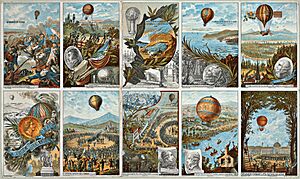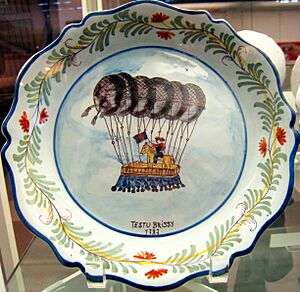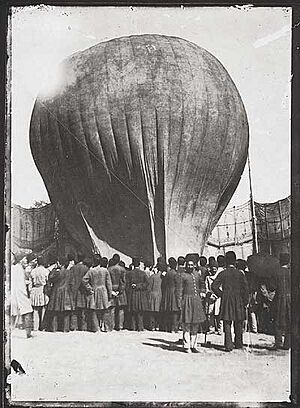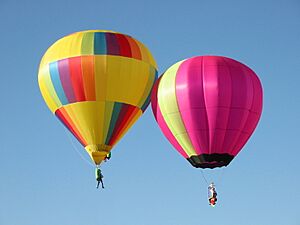History of ballooning facts for kids
The history of ballooning is super exciting! It covers hundreds of years of people dreaming about and actually flying in the sky. From simple hot air balloons to amazing gas balloons, this journey includes many "firsts." Imagine the first time a human flew, or the first time someone crossed the English Channel in a balloon! It also includes the first aircraft-related accident.
Contents
- Early Balloon Ideas and Unmanned Flights
- The First Hydrogen Balloon Takes Flight
- The First Unmanned Hot Air Balloon
- The First Manned Flights
- First Manned Hydrogen Balloon Flight
- More Amazing Balloon Achievements
- Ballooning in Britain and Ireland
- Balloons in Military History
- Balloons in the 20th Century
- Modern Day Ballooning
- Images for kids
- See also
Early Balloon Ideas and Unmanned Flights
Unmanned hot air balloons have a long history, especially in China. Around 220–280 AD, a smart general named Zhuge Liang used airborne lanterns for military signals. These lanterns are now known as Kongming lanterns. They are the oldest type of hot air balloon!
There isn't much proof of people flying in balloons before the 1700s. However, some reports suggest that the Chinese might have figured out how to fly with balloons many centuries before. The Mongolian army learned about Kongming lanterns from China. They even used them in a battle in Poland. This was probably the first time people in the Western world knew about balloons.

The first recorded balloon flight in Europe was by a Brazilian-Portuguese priest named Bartolomeu de Gusmão. On August 8, 1709, in Lisbon, he successfully lifted a small paper balloon filled with hot air. It went about four meters high in front of King John V of Portugal and his court. He also claimed to have built a larger balloon called Passarola (which means Big bird). He said he tried to fly it from Saint George Castle in Lisbon and landed about one kilometer away. This amazing claim is still debated, but it shows how early people were thinking about flying!
The First Hydrogen Balloon Takes Flight
Scientists like Robert Boyle and Henry Cavendish studied gases. Then, Joseph Black suggested that if a balloon was filled with a light gas like hydrogen, it could float! Jacques Charles, another scientist, also thought hydrogen could lift a balloon.
Jacques Charles designed the balloon. Two brothers, the Robert brothers, built a light, airtight bag for the gas. They used rubber dissolved in turpentine to make silk sheets airtight. This created the balloon's main part. They used red and white silk strips, but the rubber made the white silk turn yellow.
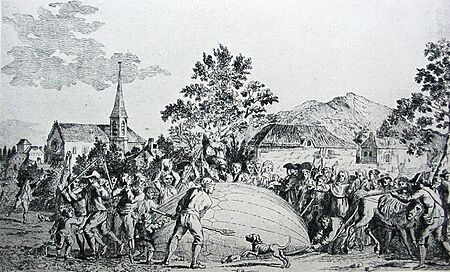
Jacques Charles and the Robert brothers started filling the world's first hydrogen balloon on August 23, 1783, in Paris. The balloon was quite small, about 13 feet across. It could only lift about 9 kilograms. They made the hydrogen gas by pouring a lot of sulfuric acid onto scrap iron. The gas was hot when it was made, and it shrank as it cooled inside the balloon. This made it hard to fill the balloon completely.
People were so excited about the balloon's progress that huge crowds gathered. On August 26, the balloon was secretly moved at night to the Champ de Mars (where the Eiffel Tower is today). On August 27, 1783, the balloon was finally released. Benjamin Franklin was among the many people watching. The balloon flew north for 45 minutes. People on horseback chased it! It landed 21 kilometers away in the village of Gonesse. The local farmers were reportedly scared and attacked it with pitchforks and knives, destroying it.
The First Unmanned Hot Air Balloon
On June 5, 1783, the Montgolfier brothers showed off their first unmanned hot-air balloon. It was about 35 feet wide. Later, on September 19, 1783, their balloon, named Aerostat Réveillon, carried the first living creatures! A sheep named Montauciel ("Climb-to-the-sky"), a duck, and a rooster were in a basket attached to the balloon.
The sheep was chosen because its body was thought to be similar to a human's. The duck was expected to be fine at high altitudes. The rooster was included as a control, since it was a bird that doesn't fly very high. This demonstration happened in front of a crowd at the royal palace in Versailles. King Louis XVI and Queen Marie Antoinette were there! The flight lasted about eight minutes, covered two miles, and reached an altitude of about 1,500 feet. The balloon landed safely.
The First Manned Flights

The first time a balloon carried human passengers was thanks to the Montgolfier brothers, Joseph-Michel and Jacques-Etienne. They were paper manufacturers and noticed ash rising from paper fires. They gave their first public demonstration on June 4, 1783. After trying out unmanned balloons and animal flights, the first tethered (tied down) balloon flight with people happened on October 19, 1783. The brave passengers were scientist Jean-François Pilâtre de Rozier, factory manager Jean-Baptiste Réveillon, and Giroud de Villette. This flight took place in Paris.
The first free flight with human passengers happened on November 21, 1783. King Louis XVI had initially suggested that certain people, who were facing serious legal consequences, should be the first pilots. However, de Rozier and the Marquis François d'Arlandes successfully asked for the honor themselves. For this flight, the balloon was almost 50 feet wide. It had a smoky fire in an iron basket hanging underneath. The pilots could control and refuel the fire. In 25 minutes, the two men traveled just over five miles. They had enough fuel to fly much farther, but burning embers from the fire threatened the balloon. So, they decided to land as soon as they were over open countryside.
News of these amazing flights spread quickly. The Montgolfier brothers' pioneering work led to this type of hot air balloon being named Montgolfière after them.
First Manned Hydrogen Balloon Flight
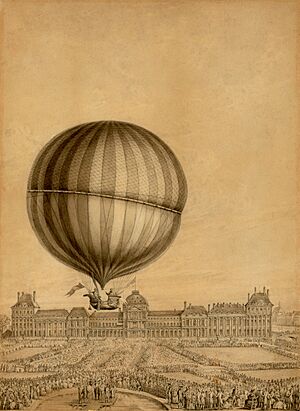
Just a few days later, on December 1, 1783, Professor Jacques Charles and the Robert brothers launched a new, manned hydrogen balloon. It took off from the Jardin des Tuileries in Paris. Huge crowds watched with excitement. Four important noblemen in France held the ropes and led the balloon to its launch spot. Jacques Charles was joined by Nicolas-Louis Robert as co-pilot. The balloon was 380 cubic meters and filled with hydrogen. It had a valve to release hydrogen and a net from which the basket hung. They used sand to control how high they flew.
They went up to about 1,800 feet (550 meters). They landed at sunset in Nesles-la-Vallée after a 125-minute flight, covering 36 kilometers. People on horseback, led by the Duc de Chartres, held the balloon down while Charles and Robert got out.
Charles then decided to go up again, but this time alone. The balloon had lost some hydrogen. He quickly went up to about 3,000 meters, where he saw the sun again! He started feeling pain in his ears, so he released some gas and gently landed about 3 kilometers away. Unlike the Robert brothers, Charles never flew again. However, gas balloons, which use hydrogen or other cold gases to lift, are called Charlière in his honor.
Charles and Robert carried a barometer and a thermometer. These tools measured the air pressure and temperature. This made their flight not only the first manned hydrogen balloon flight but also the first balloon flight to collect weather data high above the Earth!
About 400,000 people watched the launch. Hundreds paid money to get a "close-up view" of the takeoff. Benjamin Franklin, the representative from the United States of America, was there. Joseph Montgolfier was also present. Charles honored him by asking him to release a small, bright green pilot balloon to check the wind and weather.
More Amazing Balloon Achievements

The next big challenge was to fly across the English Channel. This amazing feat was achieved on January 7, 1785, by Jean-Pierre Blanchard and Dr. John Jeffries.
Sadly, the first aircraft disaster happened in May 1785. The town of Tullamore, Ireland, was badly damaged when a balloon crashed. It caused a fire that burned down about 100 houses. This made Tullamore the site of the world's first aviation disaster. Even today, the town's shield shows a phoenix rising from the ashes, symbolizing its recovery.
Blanchard also made the first manned balloon flight in America on January 10, 1793. His hydrogen balloon took off from a specific yard in Philadelphia, Pennsylvania. The flight reached 5,800 feet (1,770 meters) and landed in Gloucester County, New Jersey. President George Washington was among the people watching the takeoff. Sophie Blanchard, Jean-Pierre's wife, was the first woman to pilot her own balloon and the first woman to make ballooning her job!
Gas balloons became very popular from the 1790s until the 1960s. Pierre Testu-Brissy made over 50 flights in his life. One amazing flight was the first ascent on horseback on October 16, 1798, in Paris!
People wanted to control the balloon's direction. The first steerable balloon, also called a dirigible, was flown by Henri Giffard in 1852. It was powered by a steam engine, but it was too slow. Later, the internal combustion engine made dirigibles (especially blimps) much more practical. In 1872, Paul Haenlein flew the first balloon powered by an internal combustion engine (though it was tied down). The first person to fly in a free airship powered by an internal combustion engine was Alberto Santos Dumont in 1898.
On July 3, 2002, Steve Fossett became the first person to fly around the world alone, without stopping, in any type of aircraft. He did it in a hot air balloon! He launched his balloon, Spirit of Freedom, from Australia on June 19, 2002. He returned to Australia on July 3, landing in Queensland. This solo balloon flight lasted 13 days, 8 hours, and 33 minutes. It covered an incredible 20,626 miles (33,195 kilometers)! This trip set many ballooning records, including the fastest flight around the world (13.5 days).
Ballooning in Britain and Ireland
The first manned balloon flight in Britain was by James Tytler on August 27, 1784. Tytler flew his balloon from Abbeyhill to Restalrig, which were suburbs of Edinburgh. He flew for ten minutes at a height of 350 feet.
The first manned balloon flight in England was by Signor Vincent Lunardi. He went up from Moorfields (London) on September 15, 1784. The first British woman to fly was Letitia Ann Sage. She went up in one of Lunardi's balloons in June 1785.
Jean-Pierre Blanchard and Jeffries flew from Dover to Calais in 1785.
In Ireland, the first ascent was from Ranelagh Gardens in Dublin in 1785 by Richard Crosbie.
James Sadler made many flights in England. Sadly, on October 9, 1812, he landed in the sea but was rescued. His son, Windham Sadler, died when he fell from a balloon in 1825. Lieutenant Harris also died falling from a balloon on May 25, 1824.
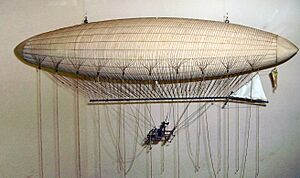
Charles Green made many flights in London between 1821 and 1852. His first flight was on July 19, 1821. He claimed that in May 1828, he took his horse up with him! This was debated, but in July 1850, he did lift off with a small pony. Later, in August 1852, Madame Poitevin took off from Cremorne Gardens in London as "Europa on a Bull." This event caused public outrage about cruelty to animals, and after that, no animals were used in such flights.
In 1836, the "Royal Vauxhall" balloon, used for fun flights, was flown by Charles Green with two crew members. After 18 hours, it landed safely in Germany. This set a record that lasted until 1907.
Robert Cocking, an artist, designed a parachute. On July 24, 1837, he went up in a balloon from Vauxhall (London) to about 1,500 meters. The parachute didn't open correctly, and Cocking was killed.
Balloons in Military History
The first time aircraft were used in war in Europe was during the French Revolutionary Wars. The French used a tied-down hydrogen balloon to watch the Austrian army during a battle in 1794.
In 1811, a man named Franz Leppich claimed he could build a hydrogen balloon for the French army to attack from the air. Napoleon stopped him. Later, in 1812, the Russian secret service helped Leppich go to Moscow. He worked on building a steerable airship to help the Russian army stop Napoleon's invasion. He built a huge inflatable blimp with a wooden platform for guns and bombs. It was supposed to be moved by forty rowers with giant paddles. The airship had problems; it leaked, and the paddles broke. When it was finally tested, it worked but couldn't move against the wind. When Napoleon invaded Russia in 1812, Leppich's airship wasn't ready. The prototype was destroyed.
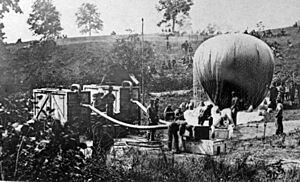
French Emperor Napoleon III used observation balloons, led by Eugène Godard, to scout battlefields in 1859 and during the Franco-Prussian War in 1870.
Hot air balloons were also used during the American Civil War. The Union Army Balloon Corps, led by Prof. Thaddeus S. C. Lowe, used balloons filled with coal gas or hydrogen.
Balloons in the 20th Century
During World War II, many barrage balloons were floated over London. These were meant to stop German air attacks during the Battle of Britain. They were a cheap defense, but they didn't stop all the damage to London. Still, they helped destroy some flying bombs.
In the early and mid-1900s, hydrogen balloons were used a lot for research high up in the atmosphere. They set many high-altitude records. When governments became less interested in manned balloons, private citizens continued to try for records. They aimed for long distances and "firsts," like the Double Eagle II (first to cross the Atlantic Ocean) and Breitling Orbiter 3 (first to fly around the world).
Today, people still go up in manned high-altitude balloons, but it's usually for adventure rather than research.
Modern Day Ballooning
Modern hot air balloons are much more advanced. They have a sophisticated heat source, unlike the Montgolfier brothers' basket of hot coals. Ed Yost pioneered these modern balloons, with his first successful flight on October 22, 1960. The first modern hot air balloon built in the United Kingdom was the Bristol Belle in 1967. Today, hot air balloons are mostly used for fun. There are about 7,500 hot air balloons operating in the United States.
The first modern tethered balloon was made in France in 1994 by Aérophile SA.
Notable Accidents
Sadly, there have been some serious ballooning accidents.
- On August 13, 1989, two hot air balloons crashed near Alice Springs, Australia. One balloon fell, killing 13 people.
- On September 12, 1995, three gas balloons in a race entered Belarusian air space. A military helicopter shot down one balloon, killing two American citizens.
- On January 7, 2012, a hot air balloon flight in New Zealand hit a power line, caught fire, and crashed. All eleven people on board died.
- On February 26, 2013, the deadliest ballooning accident happened near Luxor, Egypt. A hot air balloon exploded and crashed, killing 19 of the 21 people on board.
- On July 30, 2016, a hot air balloon carrying 16 people caught fire and crashed near Lockhart, Texas. There were no survivors.
- On January 14, 2024, a hot air balloon crashed outside Eloy, Arizona, killing three passengers and the pilot. Eight skydivers had jumped from the balloon just before the incident.
Images for kids
See also
- Aviation
- Balloon (aeronautics)
- Balloon satellite
- Bristol International Balloon Fiesta
- Cluster ballooning
- Espionage balloon
- Early flying machines
- Hot air balloon festivals
- Hot air ballooning
- Lighter than air
- List of balloon uses
- Montgolfier brothers
- Non-rigid airship (Blimp)
- Observation balloon
- Research balloon
- Skyhook balloon
- Solar balloon
- Thermal airship (Hot air airship)
- Zeppelin


